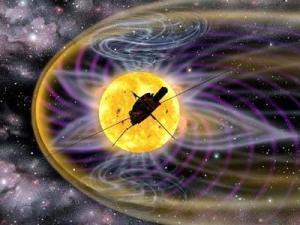Today it is expected that the old spacecraft that circled the sun from time to time and below the Melaka plane will be given a request to turn off the instruments. It will now become a man-made comet

For about 18.5 years, the spaceship Ulysses flew in space, defying all early predictions for the end of its operation. Therefore, it was jointly decided by NASA and the European Space Agency to disable communication with it today, June 30. The last transmission to the spacecraft left the ground station at 15:35 GMT (18:35 Israel time) or until the transmission of the last command - which will cause the communication system to be transferred to monitoring mode only. No further contact with Ulysses is planned.
Ulysses was the first spacecraft to survey the space environment above and below the solar poles in all four dimensions of space and time. Among the groundbreaking results achieved by the successful mission was showing that the Sun's magnetic field drifts into the Solar System in much more complex ways than previously thought. The particles ejected from the sun at low latitudes can climb to high latitudes and vice versa, unexpectedly finding their way to the planets. This is important because these areas of the Sun were not originally considered as sources of dangerous particles for astronauts and satellites and now they need to be taken into account and treated with care.
"Ulysses has taught us much more than we expected about the Sun and the way it interacts with the space around it," said Richard Marsden, the scientific director of the European Space Agency's Ulysses project and the mission manager.
The decision to disable the devices was made jointly by the two agencies, about a year after the planned end of the mission. About a year ago, one weakened from the spacecraft's power supply systems To the point where it was thought that the low temperature would cause the fuel lines to freeze and the spacecraft would become uncontrollable.
This did not happen immediately and the flight controllers realized that they could keep the fuel warm and allow it to flow by performing a short engine pulse every two hours, a solution that could continue with Ulysses' scientific missions. It was decided to keep the spacecraft in operational condition using the NASA ground station network with radio antennas with a diameter of 70 meters, based on excess capacity.
However, as Ulysses moves further away from Earth, the rate of communication has decreased while the demands on the ground station network have increased. Moreover, the overall output of the science probes had dropped to a level where it was difficult to justify the cost of maintaining Ulysses as an active spacecraft.
"We expected the spacecraft to stop working much sooner. Its longevity is credited to its builders and the people who have been involved in its operation over the years," says Paolo Perry, Head of the Division for Planetary and Solar Missions at the European Space Agency's Operations Center in Darmstadt, Germany.
He added that although it is difficult to make a decision to terminate a mission, we have come to the conclusion that the spacecraft's resources are running out and that a controlled shutdown is the best possible end.
The last operation in Ulysses will take place from NASA's Jet Propulsion Laboratory (JPL) in California. The joint team will include Nigel Arnold, the operations director of the European Space Agency, and Ed Massey - the project manager on behalf of NASA, as well as a number of engineers and analysts from both agencies.
"Tuesday will be a very sad day when we broadcast the last orders to Ulysses," Englud said. "However, I am proud that we overcame many challenges over almost two decades. The longevity is a testament to the passion for international collaborations in space missions. The European Space Agency and NASA will command and support this unique mission until the end." added
After the shutdown, the Ulysses spacecraft will continue to orbit the Sun and will effectively become a man-made comet. "Every time any of us look up in the years to come, Ulysses will be there, quietly circling the sun she has so successfully explored during a long and active life," Marsden said.

7 תגובות
To Ami Bachar - the spacecraft is in orbit around the sun, not around the earth. The load is around the earth. In open space (for example around the sun) the distances are so enormous that this spacecraft is like a grain of sand carried in the ocean.
Also, the asteroid belt is not as described in the science fiction series - it is not a very crowded area where you have to maneuver like a fighter pilot to avoid flying rocks. The chance of the spaceship getting stuck in something (unless directed, and even then it's difficult) tends to zero. Let her stay where she is now and that's it, the simplest.
Why bother turning it off? Why doesn't it turn itself off? Is it just for the gimmick?
In fact, from now on it will be called 'Ghost spaceship-Ulysses' and surely there will be others who will jump at the opportunity to publish a fascinating book about...and its events since the abandonment, thanks to the fertile imagination :)
Sad..alone in space..forever..so sad..
Another piece of space junk we threw away without cleaning up. Why don't you make sure that the end of tasks is clean? Send this chunk of metal into the sun and melt it or try to manipulate it so that the satellite escapes the gravitational force of the sun and continues towards the asteroid belt, where it will be completely destroyed by collisions.
Why do you even need to turn it off? What will happen if you keep working it bothers someone?
R.I.P.